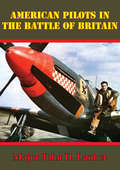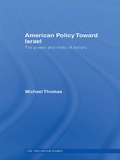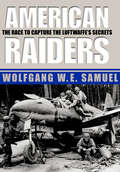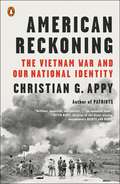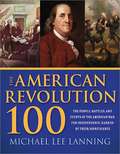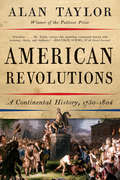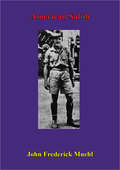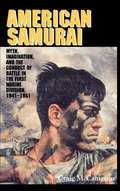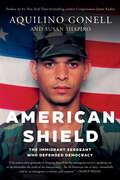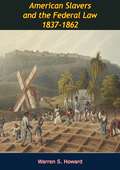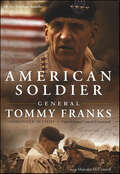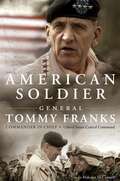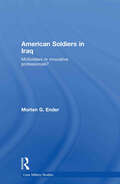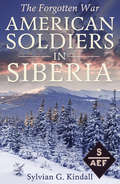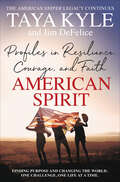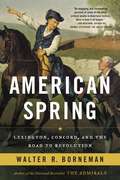- Table View
- List View
American Pendulum: Recurring Debates in U.S. Grand Strategy
by Christopher HemmerAs new presidential administrations come into power, they each bring their own approach to foreign policy. No grand strategy, however, is going to be completely novel. New administrations never start with a blank slate, so it is always possible to see similarities between an administration and its predecessors. Conversely, since each administration faces novel problems and operates in a unique context, no foreign policy strategy is going to be an exact replica of its predecessors. In American Pendulum, Christopher Hemmer examines America's grand strategic choices between 1914 and 2014 using four recurring debates in American foreign policy as lenses. First, how should the United States balance the trade-offs between working alone versus working with other states and international organizations? Second, what is the proper place of American values in foreign policy? Third, where does the strategic perimeter of the United States lie? And fourth, is time on the side of the United States or of its enemies? Offering new readings of debates within the Wilson, Truman, Nixon, Bush, and Obama administrations, Hemmer asserts that heated debates, disagreements, and even confusions over U.S. grand strategy are not only normal but also beneficial. He challenges the claim that uncertainties or inconsistences about the nation's role in the world or approach to security issues betray strategic confusion or the absence of a grand strategy. American foreign policy, he states, is most in danger not when debates are at their most pointed but when the weight of opinion crushes dissent. As the United States looks ahead to an increasingly multipolar world with increasing complicated security issues, Hemmer concludes, developing an effective grand strategy requires ongoing contestation and compromises between competing visions and policies.
American Pilots In The Battle Of Britain
by Major John D. LauherThis study determines the extent of American pilot participation as members of the Royal Air Force, flying in the Battle of Britain. It also examines the recruiting mechanism by which the Americans became involved in the war and documents their contributions as combat pilots during the battle itself.Research reveals that, while many American citizens were recruited to fly for Britain during the summer of 1940, only six Americans are known to have actually participated in the Battle of Britain, fought between 12 August and 15 September 1940. These men not only demonstrated America's determination to support her allies, but materially contributed to Britain's cause by destroying two and one half enemy aircraft, probably destroying five others, and damaging two more during their brief RAF careers.
American Policy Toward Israel: The Power and Limits of Beliefs (LSE International Studies Series)
by Michael ThomasThis book explains the institutionalization of nearly unconditional American support of Israel during the Reagan administration, and its persistence in the first Bush administration in terms of the competition of belief systems in American society and politics. Michael Thomas explains policy changes over time and provides insights into what circumstances might lead to lasting changes in policy. The volume identifies the important domestic, social, religious and political elements that have vied for primacy on policy towards Israel, and using case studies, such as the 1981 AWACS sale and the 1991 loan guarantees, argues that policy debates have been struggles to embed and enforce beliefs about Israel and about Arabs. It also establishes a framework for better understanding the influences and constraints on American policy towards Israel. An epilogue applies the lessons learned to the current Bush administration. American Policy toward Israel will be of interest to students of US foreign policy, Middle Eastern politics and international relations.
American Prisoners Of Japan: Did Rank Have Its Privilege?
by Major Michael A. Buffone ZarateThis thesis examines the story of American POWs held by the Japanese in WWII to see if there were significant differences in treatment based on rank. It examines how the Japanese treated the prisoners according to international law and also distinctions made by the officers themselves simply because of higher rank.The thesis begins by discussing the historical framework for POW rank distinctions by looking at past wars and the development of rank distinctions in international rules. It then covers the American WWII POW experience in the Far East from Bataan and Corregidor to the war's end.Special emphasis is placed on distinctions made in food, housing, pay, medical care, camp administration, work requirements, escape opportunities, transportation, leadership problems, and overall death rates.The study concludes that there were significant differences in treatment based on rank. These differences caused extremely high enlisted death rates during the first year of captivity. The officers fared worse as a group, however, because the Japanese held them in the Philippines until late 1944 because international rules prevented the Japanese from using officers in Japan's labor camps. During shipment to Japan many officers died when the unmarked transport ships were sunk by advancing American forces.
American Public Opinion on the Iraq War
by Ole R. Holsti"A substantial contribution to understanding the role of public opinion and the news media during the Iraq War. Equally impressive, it effectively puts the domestic context of U. S. policy in historical perspective, making the book useful to historians as well as to political scientists. " ---Ralph B. Levering, Davidson College "American Public Opinion on the Iraq Warsets out to chart against a detailed account of the war a nuanced assessment of how public opinion on the conflict evolved, the partisan differences that emerged, how the issue affected other areas of foreign policy opinion, and the limits of public opinion on policy. It succeeds at all of this, and it does so in a manner that is at once informative, inherently interesting, and exceptionally easy to read. " ---Randolph M. Siverson, University of California, Davis Ole R. Holsti explores the extent to which changes in public opinion reflected the vigorous public relations efforts of the Bush administration to gain support for the war and the partisanship marking debates over policies toward Iraq. Holsti investigates the ways in which the Iraq experience has led substantial numbers of Americans to reconsider their nation's proper international role, and he assesses the impact that public opinion has had on policymakers. Significantly, Holsti places his findings in a broader context to address the role of public opinion and of the media in democratic governance.
American Raiders: The Race to Capture the Luftwaffe’s Secrets
by Colonel Wolfgang W. SamuelAt the close of World War II, Allied forces faced frightening new German secret weapons—buzz bombs, V-2's, and the first jet fighters. When Hitler's war machine began to collapse, the race was on to snatch these secrets before the Soviet Red Army found them. The last battle of World War II, then, was not for military victory but for the technology of the Third Reich. In American Raiders: The Race to Capture the Luftwaffe's Secrets, Wolfgang W. E. Samuel assembles from official Air Force records and survivors' interviews the largely untold stories of the disarmament of the once mighty Luftwaffe and of Operation Lusty—the hunt for Nazi technologies. In April 1945 American armies were on the brink of winning their greatest military victory, yet America's technological backwardness was shocking when measured against that of the retreating enemy. Senior officers, including the Commanding General of the Army Air Forces Henry Harley “Hap” Arnold, knew all too well the seemingly overwhelming victory was less than it appeared. There was just too much luck involved in its outcome. Two intrepid American Army Air Forces colonels set out to regain America's technological edge. One, Harold E. Watson, went after the German jets; the other, Donald L. Putt, went after the Nazis' intellectual capital—their world-class scientists. With the help of German and American pilots, Watson brought the jets to America; Putt persevered as well and succeeded in bringing the German scientists to the Army Air Forces' aircraft test and evaluation center at Wright Field. A young P-38 fighter pilot, Lloyd Wenzel, a Texan of German descent, then turned these enemy aliens into productive American citizens—men who built the rockets that took America to the moon, conquered the sound barrier, and laid the foundation for America's civil and military aviation of the future. American Raiders: The Race to Capture the Luftwaffe's Secrets details the contest won, a triumph that shaped America's victories in the Cold War.
American Reckoning
by Christian G. Appy"Few people understand the centrality of the Vietnam War to our situation as much as Christian Appy."--Ken BurnsThe critically acclaimed author of Patriots offers profound insights into Vietnam's place in America's self-image. How did the Vietnam War change the way we think of ourselves as a people and a nation? Christian G. Appy, author of the widely praised oral history of the Vietnam War Patriots, now examines the relationship between the war's realities and myths and its impact on our national identity, conscience, pride, shame, popular culture, and postwar foreign policy.Drawing on a vast variety of sources from movies, songs, and novels to official documents, media coverage, and contemporary commentary, Appy offers an original interpretation of the war and its far-reaching consequences. Authoritative, insightful, sometimes surprising, and controversial, American Reckoning is a fascinating mix of political and cultural reporting that offers a completely fresh account of the meaning of the Vietnam War.
American Revolution 100: The Battles, People, and Events of the American War for Independence, Ranked by Their Significance
by Michael Lee LanningA controversial ranking of the Revolution's biggest battles, events, and leaders. The American Revolution 100 brings you onto the charred battlefields and inside the maneuverings of the war that produced America. In comprehensive fashion it explains, analyzes, and ranks the war's most significant events, leaders, and battles according to their importance. Celebrated veteran and military expert Michael Lee Lanning introduces the war's various causes and primary players. The 100 ranked entries that follow include bloody battles, outspoken politicians, military heroes, causes of the conflict, and monumental events. The War of Independence pitted king against colonialist, monarchy against democracy. Men risked execution for treason in order to bring about the model government that would inspire a world. The American Revolution 100 brings to life its battles, people, and events, including maps and illustrations.
American Revolutions: A Continental History, 1750 - 1804
by Alan Taylor“Excellent . . . deserves high praise. Mr. Taylor conveys this sprawling continental history with economy, clarity, and vividness.”—Brendan Simms, Wall Street Journal The American Revolution is often portrayed as a high-minded, orderly event whose capstone, the Constitution, provided the nation its democratic framework. Alan Taylor, a two-time Pulitzer Prize winner, gives us a different creation story in this magisterial history. The American Revolution builds like a ground fire overspreading Britain’s colonies, fueled by local conditions and resistant to control. Emerging from the continental rivalries of European empires and their native allies, the revolution pivoted on western expansion as well as seaboard resistance to British taxes. When war erupted, Patriot crowds harassed Loyalists and nonpartisans into compliance with their cause. The war exploded in set battles like Saratoga and Yorktown and spread through continuing frontier violence. The discord smoldering within the fragile new nation called forth a movement to concentrate power through a Federal Constitution. Assuming the mantle of “We the People,” the advocates of national power ratified the new frame of government. But it was Jefferson’s expansive “empire of liberty” that carried the revolution forward, propelling white settlement and slavery west, preparing the ground for a new conflagration.
American Sahib
by John MuehlAN AMERICAN MEDIC ATTACHED TO THE BRITISH INDIAN ARMY DURING WORLD WAR TWO RECOUNTS HIS EXPERIENCES.John Muehl saw India as few Americans, few Britons, and few Indians ever have the chance to see it. He was with the American Field Service, attached to the British Indian Army, and wore British uniform. "I could travel the length and breadth of the country, with the blessing of the Raj but without its stigma. I was a 'pukah sahib' in the Poona Club, a tommy in the Lady Lumley Canteen, an American tourist in Gorpuri Bazaar, and simply a friend to Raman and Singh." He mingled with the Sikhs and Gurkhas and other Indians who fought under the British not for love of empire or for hate of Japan but for their board and keep. "Nay British sahib-American sahib," he would say when Indians showed reluctance to talk with him. Admiration for America was great enough-though it turned to suspicion by the end of this war in which America seemed to make common cause with the Raj-so that this phrase usually broke down the barrier. And AMERICAN SAHIB is John Muehl's journal of a year. It is an inside story of appalling poverty, famine, and political ferment among the Indians, and of bungling, brutality, and hypocrisy on the part of the British rulers. Fortunately for the reader, the dark picture is lightened with humor and with a sense of the patient philosophy that sustains India. This young American's first shock came when he learned through personal conversations in exclusive officer's clubs that the Briton in India does not conceive himself as graciously bearing the white man's burden, as the propaganda would have us believe. In private, the Briton admits almost boastfully that India's function is to serve as a source of raw materials for England and a market for her products, and if she is ground down in the process that is her worry...Through John Muehl's eyes and ears, we too can see India and hear its people.
American Samurai: Myth and Imagination in the Conduct of Battle in the First Marine Division 1941-1951
by Craig CameronA study of the cultural myths and imagination concerning the Marine Corps before, during and after World War Two and the influence these had on the war.
American Shield: The Immigrant Sergeant Who Defended Democracy
by Susan Shapiro Aquilino Gonell&“American Shield is an all-American tale of duty and determination—beautifully told by an immigrant, a veteran, and a patriot.&” —Nancy Pelosi, Speaker Emerita of the United States House of RepresentativesSet against the extraordinary events of January 6, 2021, Aquilino Gonell&’s inspirational memoir is rooted in the joys and struggles of the immigrant experience that have long defined the American experimentAquilino Gonell came to the United States from the Dominican Republic as a young boy. Although he spoke no English, he dedicated himself to his adopted land, striving for the American dream. Determined to be a success story, he joined the army to pay for college. He saw action in Iraq and returned home with PTSD. Believing in the promise of our government, he focused on healing himself and supporting his family. His hard work paid off when he landed a coveted position with the United States Capitol Police and rose to the rank of sergeant.January 6, 2021, changed everything. When insurrectionists stormed the Capitol, Gonell bravely faced down the mob attempting to thwart the peaceful transfer of power. The brutal injuries he sustained that day would end his career in law enforcement. But when some of the very people he put his life on the line to protect downplayed or denied the truth of that day, he chose to speak out against the injustice done to him and the country. Chronicling what it means to live a life of conviction, one that adheres to the best ideas of our democracy, American Shield is a bold testament to the power of truth, justice, and accountability from a highly decorated officer and immigrant who exemplifies the greatest aspirations of a grateful nation.
American Slavers and the Federal Law 1837-1862
by Warren S. HowardDetailed study of the American government's inability to deal with flagrant violations of federal laws forbidding the use of American citizens, vessels, and port facilities in the international slave trade which flourished in the 1840s and 1850s.
American Sniper: La autobiografía del francotirador mAs l
by Jim Defelice Chris Kyle Scott McewenSPANISH EDITION: Gripping, eye-opening, and powerful, American Sniper is the astonishing autobiography of SEAL Chief Chris Kyle, who is the record-holding sniper in U.S. military history. Kyle has more than 150 officially confirmed kills (the previous American record was 109), though his remarkable career total has not been made public by the Pentagon. In this New York Times bestselling, Kyle shares the true story of his extraordinary decade-long career, including his multiple combat tours in Iraq (Operation Iraqi Freedom) and elsewhere from 1999-2009. Kyle’s riveting first-person account of how he went from Texas rodeo cowboy to expert marksman and feared assassin offers a fascinating view of modern-day warfare and one of the most in-depth and illuminating looks into the secret world of Special Ops ever written. He was the top American sniper of all time, called "the legend" by his Navy SEAL brothers, and a hero by those he served on the home front . . . From 1999 to 2009, U.S. Navy SEAL Chris Kyle recorded the most career sniper kills in United States military history. Kyle earned legendary status among his fellow SEALs, Marines, and U.S. Army soldiers, whom he protected with deadly accuracy from rooftops and stealth positions. Gripping and unforgettable, Kyle's masterful account of his extraordinary battlefield experiences ranks as one of the greatest war memoirs of all time. A native Texan who learned to shoot on childhood hunting trips with his father, Kyle was a champion saddle-bronc rider prior to joining the Navy. After 9/11, he was thrust onto the front lines of the War on Terror, and soon found his calling as a world-class sniper who performed best under fire. He recorded a personal-record 2,100-yard kill shot outside Baghdad; in Fallujah, Kyle braved heavy fire to rescue a group of Marines trapped on a street; in Ramadi, he stared down insurgents with his pistol in close combat. Kyle talks honestly about the pain of war—of twice being shot, and experiencing the tragic deaths of two close friends. American Sniper also honors Kyle's fellow warriors, who raised hell on and off the battlefield. And in moving first-person accounts throughout, Kyle's wife, Taya, speaks openly about the strains of war on their marriage and children, as well as on Chris. Adrenaline-charged and deeply personal, American Sniper is a thrilling eyewitness account of service and sacrifice that only one man could tell.
American Sniper: The Autobiography of the Most Lethal Sniper in U. S. Military History
by Jim Defelice Chris Kyle Scott McewenA celebration of the remarkable life and legacy of fallen American hero Chris Kyle<P> This commemorative memorial edition of Kyle's bestselling memoir features the full text of American Sniper, plus more than eighty pages of remembrances by those whose lives he touched personally--including his wife, Taya; his parents, brother, and children; Marcus Luttrell and other fellow Navy SEALs; veterans and wounded warriors; lifelong friends; and many others.<P> He was the top American sniper of all time, called "the legend" by his Navy SEAL brothers, and a hero by those he served on the home front . . .From 1999 to 2009, U.S. Navy SEAL Chris Kyle recorded the most career sniper kills in United States military history. Kyle earned legendary status among his fellow SEALs, Marines, and U.S. Army soldiers, whom he protected with deadly accuracy from rooftops and stealth positions. Gripping and unforgettable, Kyle's masterful account of his extraordinary battlefield experiences ranks as one of the greatest war memoirs of all time.<P> A native Texan who learned to shoot on childhood hunting trips with his father, Kyle was a champion saddle-bronc rider prior to joining the Navy. After 9/11, he was thrust onto the front lines of the War on Terror, and soon found his calling as a world-class sniper who performed best under fire. He recorded a personal-record 2,100-yard kill shot outside Baghdad; in Fallujah, Kyle braved heavy fire to rescue a group of Marines trapped on a street; in Ramadi, he stared down insurgents with his pistol in close combat. Kyle talks honestly about the pain of war--of twice being shot, and experiencing the tragic deaths of two close friends.American Sniper also honors Kyle's fellow warriors, who raised hell on and off the battlefield. And in moving first-person accounts throughout, Kyle's wife, Taya, speaks openly about the strains of war on their marriage and children, as well as on Chris.<P> Adrenaline-charged and deeply personal, American Sniper is a thrilling eyewitness account of service and sacrifice that only one man could tell.
American Sniper: The Autobiography of the Most Lethal Sniper in U.S. Military History
by Jim Defelice Chris Kyle Scott Mcewen<P>He is the deadliest American sniper ever, called "the devil" by the enemies he hunted and "the legend" by his Navy SEAL brothers . . . <P>From 1999 to 2009, U.S. Navy SEAL Chris Kyle recorded the most career sniper kills in United States military history. <P>The Pentagon has officially confirmed more than 150 of Kyle's kills (the previous American record was 109), but it has declined to verify the astonishing total number for this book. <P>Iraqi insurgents feared Kyle so much they named him al-Shaitan ("the devil") and placed a bounty on his head. <P>Kyle earned legendary status among his fellow SEALs, Marines, and U.S. Army soldiers, whom he protected with deadly accuracy from rooftops and stealth positions. <P>Gripping and unforgettable, Kyle's masterful account of his extraordinary battlefield experiences ranks as one of the great war memoirs of all time. <P>A native Texan who learned to shoot on childhood hunting trips with his father, Kyle was a champion saddle-bronc rider prior to joining the Navy. <P>After 9/11, he was thrust onto the front lines of the War on Terror, and soon found his calling as a world-class sniper who performed best under fire. <P>He recorded a personal-record 2,100-yard kill shot outside Baghdad; in Fallujah, Kyle braved heavy fire to rescue a group of Marines trapped on a street; in Ramadi, he stared down insurgents with his pistol in close combat. <P>Kyle talks honestly about the pain of war--of twice being shot and experiencing the tragic deaths of two close friends. <P>American Sniper also honors Kyles fellow warriors, who raised hell on and off the battlefield. And in moving first-person accounts throughout, Kyle's wife, Taya, speaks openly about the strains of war on their marriage and children, as well as on Chris. <P>Adrenaline-charged and deeply personal, American Sniper is a thrilling eyewitness account of war that only one man could tell.
American Soldier
by Tommy R. Franks Malcolm McConnellTo America, he was a hero.To his troops, he was a soldier.Now hear his story.Each new era in American history has given rise to a military leader who defines the nation’s proudest traditions—of leadership and honor, of vision and commitment and courage in the face of any challenge. From Washington and U.S. Grant to Dwight D. Eisenhower and Norman Schwarzkopf, these men have captured the nation’s imagination, and entered the small pantheon of
American Soldier
by Tommy FranksThe autobiography of General Tommy Franks. A look at the war on terrorism from someone who served on the frontlines as both a warrior and a diplomat.
American Soldier of WWII: D-Day, A Visual Reference
by Denis HambuckenOn June 6, 1944, 75,000 American men landed on the beaches of Normandy. The opening act in the liberation of Western Europe was the most ambitious military operation in history. This book provides an intimate look at soldiers' day-to-day experience through period equipment, weapons, and personal belongings. American Soldier of World War II provides a detailed look at the lives, weapons, and equipment of the soldiers who fought in the European Theater through a collection of artifacts and exacting reproductions. While other books examine World War II from a political, tactical, or military perspective, this book focuses on the day-to-day life and the human experience of the American men who fought and often gave their lives to defeat fascism. Illustrated with full-color photographs and historical documents, engagingly written and thoroughly explained, this book is the perfect addition to children's and adults' library collections, school libraries, and the personal libraries of history buffs of all ages.
American Soldiers in Iraq: McSoldiers or Innovative Professionals? (Cass Military Studies)
by Morten G. EnderAmerican Soldiers in Iraq offers a unique snapshot of American soldiers in Iraq, analyzing their collective narratives in relation to the military sociology tradition. Grounded in a century-long tradition of sociology offering a window into the world of American soldiers, this volume serves as a voice for their experience. It provides the reader with both a generalized and a deep view into a major social institution in American society and its relative constituents-the military and soldiers-during a war. In so doing, the book gives a backstage insight into the U.S. military and into the experiences and attitudes of soldiers during their most extreme undertaking-a forward deployment in Iraq while hostilities are intense. The author triangulates qualitative and quantitative field data collected while residing with soldiers in Iraq, comparing and contrasting various groups from officers to enlisted soldiers, as well as topics such as boredom, morale, preparation for war, day-to-day life in Iraq, attitudes, women soldiers, communication with the home-front, "McDonaldization" of the force, civil-military fusion, the long-term impact of war, and, finally, the socio-demographics of fatalities. The heart of American Soldiers in Iraq captures the experiences of American soldiers deployed to Operation Iraqi Freedom at the height of the conflict in a way unprecedented in the literature to date. This book will be essential reading for students of military studies, sociology, American politics and the Iraq War, as well as being of much interest to informed general readers.
American Soldiers in Siberia
by Sylvian G. KindallAmerican Soldiers in Siberia by U.S. Army officer Sylvian G. Kindall (first published in 1945), recounts his experiences as a member of the American Expeditionary Force Siberia from 1918 to 1920. AEF Siberia was involved in the Russian Civil War in and around Vladivostok at the end of World War I following the October Revolution. The futility and unpreparedness of the mission is apparent throughout the book, as is the author’s intense disdain for the Japanese troops, who were witnessed in repeated acts of violence against an unarmed citizenry. President Woodrow Wilson’s claimed objectives for sending troops to Siberia were both diplomatic and military: (1) rescue the 40,000 men of the Czechoslovak Legions, who were being harassed by Bolshevik forces as they attempted to make their way along the Trans-Siberian Railroad to Vladivostok; (2) to protect the large quantities of military supplies and railroad rolling stock that the United States had sent to the Russian Far East in support of the prior Russian government’s war efforts on the Eastern Front; (3) the need to “steady any efforts at self-government or self defense in which the Russians themselves may be willing to accept assistance.” At the time, Bolshevik forces controlled only small pockets in Siberia and Wilson wanted to ensure that neither Cossack marauders nor the Japanese military would take advantage of the unstable political environment along the strategically important railroad line located in this resource-rich region. For similar reasons, about 5,000 American soldiers were also sent to Arkhangelsk (Archangel), Russia by President Wilson as part of the separate Polar Bear Expedition.
American Spartan: The Promise, the Mission, and the Betrayal of Special Forces Major Jim Gant
by Ann Scott TysonA gripping account of a U.S. Army Special Forces major’s journey into the tribal Pashtuns of Afghanistan by a Pulitzer Prize–nominated author.One of the most charismatic, controversial U.S. commanders of modern memory, Army Special Forces Major Jim Gant changed the face of America’s war in Afghanistan when his critical white paper, “One Tribe at a Time,” went viral at the Pentagon, the White House, and on Capitol Hill in 2009.A decorated Green Beret who had spent years training indigenous fighters, Jim argued for embedding autonomous units with tribes across Afghanistan: these American soldiers would live among Afghans for extended periods, not only to train tribal militias but also to fight with them in battle. He argued that these small U.S. teams could earn the trust of the Afghans and transform them into reliable allies with whom we could defeat the Taliban and Al Qaeda networks.Correspondent Ann Scott Tyson came to share Jim’s vision that Americans and Pashtuns could fight side-by-side and create real change across the region, so she accompanied him to Afghanistan. This remarkable story—of Jim’s close relationships with village elder Noor Afzhal, the fierce fighting they took straight to the enemy in the mountains of Konar Province, and Ann and Jim’s deepening love for each other—is told with a keen sense of drama and immediacy.A story like no other, American Spartan is one of the most remarkable and emotionally resonant narratives of war ever published.
American Speeches: Political Oratory from Abraham Lincoln to Bill Clinton
by Ted WidmerFrom the book: Public speeches have profoundly shaped American history and culture, transforming not only our politics but also our language and our sense of national identity. This volume collects the unabridged texts of 83 eloquent and dramatic speeches delivered by 45 American public figures between 1865 and 1997, beginning with Abraham Lincoln's last speech on Reconstruction and ending with Bill Clinton's heartfelt tribute to the Little Rock Nine. During this period American political oratory continued to evolve, as a more conversational style, influenced by the intimacy of radio and television, emerged alongside traditional forms of rhetoric. Included are speeches on Reconstruction by Thaddeus Stevens and African-American congressman Robert Brown Elliott, Frederick Douglass's brilliant oration on Abraham Lincoln, and Oliver Wendell Holmes's "touched with fire" Memorial Day Address. Speeches by Robert Ingersoll and William Jennings Bryan capture the fervor of 19th-century political conventions, while Theodore Roosevelt and Carl Schurz offer opposing views on imperialism. Ida B. Wells and Mary Church Terrell denounce the cruelty of lynching and the injustice of Jim Crow; Susan B. Anthony, Elizabeth Cady Stanton, and Carrie Chapman Catt advocate the enfranchisement of women; and Woodrow Wilson and Henry Cabot Lodge present conflicting visions of the League of Nations. Also included are wartime speeches by George Patton and Dwight Eisenhower; an address on the atomic bomb by J. Robert Oppenheimer; Richard Nixon's "Checkers Speech"; Malcolm X's "The Ballot or the Bullet"; Barry Goldwater's speech to the 1964 Republican convention; Mario Savio urging Berkeley students to stop "the machine"; Barbara Jordan defending the Constitution during Watergate; and an extensive selection of speeches by Franklin Roosevelt, Martin Luther King, John F. Kennedy, and Ronald Reagan. Ted Widmer, editor, is t
American Spirit: Profiles in Resilience, Courage, and Faith
by Taya Kyle Jim DeFeliceThe "American Sniper" legacy continues: Taya Kyle celebrates the American Spirit in her inspiring new bookLife leads us through difficult terrain. But what happens if you use challenge as an opportunity to discover your PURPOSE? These Americans did and are changing the world. After losing her husband, "American Sniper" Chris Kyle, bestselling author Taya Kyle entered a period of deep grief. And yet the experience served as a catalyst for profound growth. Taya found her own reserve of strength with the help of the generous love and support of family and friends—and also many strangers across America, who selflessly shared their own stories of suffering, survival, and triumph. Inspired by her experience, Taya discovered her calling: spreading a message of how love, passion, and service can combine to help us persevere over personal pain and heal our communities. Working with trusted collaborator Jim DeFelice (coauthor of American Sniper and American Wife), Taya tells her own story, as well as those of other Americans who have built extraordinary lives after traveling down life’s most difficult roads—through loss, illness, all manner of setback. They embody the “American spirit” of resilience, faith, togetherness that has built the nation. American Spirit profiles more than 30 individuals, young and old, rich and not-so-rich, famous and unknown, who have overcome hardship and done extraordinary things for their communities and for the nation at large. The 9/11 survivor, badly burned over 60% of his body, who asked himself What debt do I owe to God? And to my fellow human beings? What am I supposed to do with this miracle of survival? The man with the hole in his heart who runs ultramarathons. The young cancer victim whose lemonade stand inspired a revolutionary new model for fighting cancer. The blind cyclist; the pastor who became an undercover investigator, and more. In the end, these stories teach us how to find purpose and heal the world, no matter the difficulty. “Every action, big or small,” Taya writes, “has the potential to spark someone else’s movement.”
American Spring: Lexington, Concord, and the Road to Revolution
by Walter R. BornemanA vibrant new look at the American Revolution's first months, from the author of the bestseller The Admirals When we reflect on our nation's history, the American Revolution can feel almost like a foregone conclusion. In reality, the first weeks and months of 1775 were very tenuous, and a fractured and ragtag group of colonial militias had to coalesce rapidly to have even the slimmest chance of toppling the mighty British Army.AMERICAN SPRING follows a fledgling nation from Paul Revere's little-known ride of December 1774 and the first shots fired on Lexington Green through the catastrophic Battle of Bunker Hill, culminating with a Virginian named George Washington taking command of colonial forces on July 3, 1775.Focusing on the colorful heroes John Hancock, Samuel Adams, Mercy Otis Warren, Benjamin Franklin, and Patrick Henry, and the ordinary Americans caught up in the revolution, Walter R. Borneman uses newly available sources and research to tell the story of how a decade of discontent erupted into an armed rebellion that forged our nation.

